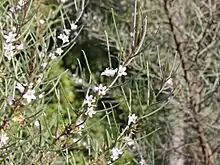| Salt myoporum | |
|---|---|
 | |
| Myoporum turbinatum in the ANBG | |
| Scientific classification | |
| Kingdom: | Plantae |
| Clade: | Tracheophytes |
| Clade: | Angiosperms |
| Clade: | Eudicots |
| Clade: | Asterids |
| Order: | Lamiales |
| Family: | Scrophulariaceae |
| Genus: | Myoporum |
| Species: | M. turbinatum |
| Binomial name | |
| Myoporum turbinatum | |
Myoporum turbinatum, commonly known as salt myoporum,[2] is a plant in the figwort family, Scrophulariaceae and is endemic to a small area near Esperance in Western Australia. It is closely related to Myoporum platycarpum but has much narrower leaves and differently shaped fruit. Its sticky branches and narrow, warty leaves are distinctive.
Description
Myoporum turbinatum is an erect shrub which sometimes grows to a height of 4 metres (10 ft). Young plants have many stems but as they mature, more often have only a few warty, sticky, stems which are only leafy towards their ends. The leaves are arranged alternately and are linear in shape, usually 15–50 millimetres (0.6–2 in) long, 0.5–1.0 millimetre (0.02–0.04 in) wide, shiny, warty and sticky. There is a groove extending along both sides of the leaves and both sides of the leaves are the same, usually dark green colour.[3][4]
The flowers are borne in leaf axils, usually in groups of 4 to 8 on stalks 1.5–4.5 millimetres (0.06–0.2 in) long. There are 5 egg-shaped sepals and 5 petals forming a bell-shaped tube. The petals are white or slightly pink, sometimes spotted inside the tube and on the base of the lobes. The tube is 3–4 millimetres (0.1–0.2 in) long and the lobes are shorter than the length of the tube. Flowers are produced in most months, except during droughts. The fruits that follow are dry and shaped like a top, flattened with a point on the end and 3–4.5 by 1.5–2.5 millimetres (0.1 in–0.2 in × 0.06 in–0.1 in).[3][4][5]
Taxonomy and naming
Myoporum turbinatum was first formally described by taxonomist Bob Chinnock in Nuytsia in 1986[2][3] from a specimen collected in the north east of Esperance. The specific epithet (turbinatum) is a Latin word meaning "shaped like a top", referring to the fruit.[3][6]
Distribution and habitat
Salt myoporum occurs in a small area north east of Esperance in the Mallee biogeographic region, where it grows near salty areas in sandy soils, often in association with Melaleuca, Hakea and Eucalyptus species.[3][4][7][8]
Conservation
Myoporum turbinatum has been classified as "Priority 4" by the Government of Western Australia Department of Parks and Wildlife[7] meaning that it is rare or near threatened.[9]
References
- ↑ "Myoporum turbinatum". Australian Plant Census. Retrieved 6 September 2020.
- 1 2 "Myoporum turbinatum". APNI. Retrieved 6 September 2020.
- 1 2 3 4 5 Chinnock, R.J. (Bob) (2007). Eremophila and allied genera : a monograph of the plant family Myoporaceae (1st ed.). Dural, NSW: Rosenberg. pp. 155–156. ISBN 9781877058165.
- 1 2 3 Taylor, Heather; Butler, Ryan; Brown, Andrew. "Salt Myoporum (Myoporum turbinatum) Interim Recovery Plant 2004-2009" (PDF). Australian Government Department of the Environment. Retrieved 29 November 2015.
- ↑ Archer, William. "Myoporum turbinatum". Esperance Wildflowers. Retrieved 29 November 2015.
- ↑ Francis Aubie Sharr (2019). Western Australian Plant Names and their Meanings. Kardinya, Western Australia: Four Gables Press. p. 329. ISBN 9780958034180.
- 1 2 "Myoporum turbinatum Chinnock". FloraBase. Western Australian Government Department of Biodiversity, Conservation and Attractions.
- ↑ Paczkowska, Grazyna; Chapman, Alex R. (2000). The Western Australian flora : a descriptive catalogue. Perth: Wildflower Society of Western Australia. p. 344. ISBN 0646402439.
- ↑ "Conservation codes for Western Australian Flora and Fauna" (PDF). Government of Western Australia Department of Parks and Wildlife. Retrieved 11 April 2020.
